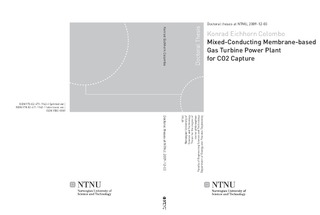| dc.contributor.author | Colombo, Konrad Eichhorn | nb_NO |
| dc.date.accessioned | 2014-12-19T11:43:56Z | |
| dc.date.available | 2014-12-19T11:43:56Z | |
| dc.date.created | 2010-02-26 | nb_NO |
| dc.date.issued | 2009 | nb_NO |
| dc.identifier | 300618 | nb_NO |
| dc.identifier.isbn | 978-82-471-1962-4 (printed ver.) | nb_NO |
| dc.identifier.isbn | 978-82-471-1963-1 (electronic ver.) | nb_NO |
| dc.identifier.uri | http://hdl.handle.net/11250/233436 | |
| dc.description.abstract | At present, approximately 81% of the world's primary energy use relies on fossil fuels (natural gas, coal, and oil). As a result, emissions of the greenhouse gas CO2 have increased dramatically, resulting in major effects on the climate of the globe. One option for reducing anthropogenic CO2 emissions to the atmosphere is to capture the CO2 produced by large, stationary point sources, such as power plants, and to store it in geological formations.
There are basically three technologies for CO2 capture from power plants: postcombustion, pre-combustion, and oxy-combustion. The use of mixed-conducting membranes for integrated air separation in oxy-combustion power plants is often referred to as a promising technology with a relatively small efficiency penalty. However, this type of membrane adds several operational and material constraints that need to be considered to obtain sound process performance. The membrane-based gas turbine power plant analysed in this work includes a membrane reactor, where large amounts of CO2 and H2O are recycled to moderate the combustion temperature and to increase the driving force for oxygen permeation rates through the membranes. The membrane operates in a narrow range with respect to temperature, interactions with gaseous species such as CO2, and temperature gradients. The use of mixed-conducting membranes for integrated air separation also creates a need for other critical process components that adds further constraints.
The membrane-based power plant was analysed with respect to design performance, steady-state and transient part-load (off-design) operation, transient response to failures, and performance deterioration due to degradation of individual process components as well as start-up and shut-down procedures. There was an emphasis on operational and material constraints that need to be considered to achieve a reasonable lifetime of critical process components.
A multi-scale modelling approach for the time and spatial domains was chosen for the detailed analysis of the membrane-based gas turbinef power plant. Key process components were based on spatially distributed conservation balances for energy, species, and mass. A stability diagram was incorporated into the membrane module model to investigate the risk of degradation. Performance maps were employed for proper off-design performance of the turbomachinery components.
For part-load operation, two load-control strategies were analysed for a mid merit gas turbine operating at constant rotational speed. In the first load-control strategy, variable guide vanes in the gas turbine compressor were used to manipulate the mass flow of air to the gas turbine compressor. This degree of freedom was used to control the turbine exit temperature. In the second load-control strategy, variable guide vanes were not used and the turbine exit temperature was allowed to vary. The mean solidwall temperature of the membrane modules was maintained close to its design value, which leads to improved stability. Furthermore, the pressure in the recycle loop was controlled to minimize the mechanical load to the walls of the monolithic membrane modules and heat exchangers. Steam must be added to the membrane reactor to sustain sound process conditions.
It was found that the membrane-based gas turbine power plant had a narrow operating window due to operational and material constraints, when compared to a conventional gas turbine power plant. Moreover, the membrane-based power plant exhibits rather slow dynamics. Fast load-following is thus not recommended, nor is it even possible. Two more general conclusions can be drawn from this work. First, the analysis of complex technical systems, such as the membrane-based power plant, should not be subdivided into (i) design, (ii) off-design, and (iii) transient analysis. For instance, a process may have inherent dynamics that lead to constraining conditions for offdesign operation. Secondly, operational and material constraints must be considered to arrive at a more realistic picture of the feasibility of novel processes | nb_NO |
| dc.language | eng | nb_NO |
| dc.publisher | Norges teknisk-naturvitenskapelige universitet, Fakultet for ingeniørvitenskap og teknologi, Institutt for energi- og prosessteknikk | nb_NO |
| dc.relation.ispartofseries | Doktoravhandlinger ved NTNU, 1503-8181; 2009:269 | nb_NO |
| dc.relation.haspart | Colombo, Konrad Eichhorn; Imsland, Lars; Bolland, Olav; Hovland, Svein. Dynamic modelling of an oxygen mixed-conducting membrane and model reduction for control. Journal of Membrane Science. (ISSN 0376-7388). 336(1-2): 50-60, 2009. <a href='http://dx.doi.org/10.1016/j.memsci.2009.02.035'>10.1016/j.memsci.2009.02.035</a>. | nb_NO |
| dc.relation.haspart | Colombo, Konrad Eichhorn; Bolland, Olav; Kharton, Vladislav V.; Stiller, Christoph. Simulation of an oxygen membrane-based combined cycle power plant:part-load operation with operational and material constraints. Energy & Environmental Science. (ISSN 1754-5692). 2(11): 1310-1324, 2009. <a href='http://dx.doi.org/10.1039/b910124a'>10.1039/b910124a</a>. | nb_NO |
| dc.relation.haspart | Colombo, Konrad Eichhorn; Kharton, Vladislav V.; Bolland, Olav. Simulation of an Oxygen Membrane-Based Gas Turbine Power Plant: Dynamic Regimes with Operational and Material Constraints. Energy & Fuels. (ISSN 0887-0624). 24(1): 590-608, 2010. <a href='http://dx.doi.org/10.1021/ef9004253'>10.1021/ef9004253</a>. | nb_NO |
| dc.title | Mixed-Conducting Membrane based Gas Turbine Power Plant for CO2 Capture | nb_NO |
| dc.type | Doctoral thesis | nb_NO |
| dc.contributor.department | Norges teknisk-naturvitenskapelige universitet, Fakultet for ingeniørvitenskap og teknologi, Institutt for energi- og prosessteknikk | nb_NO |
| dc.description.degree | Dr.philos. | nb_NO |
| dc.description.degree | Dr.philos. | en_GB |

